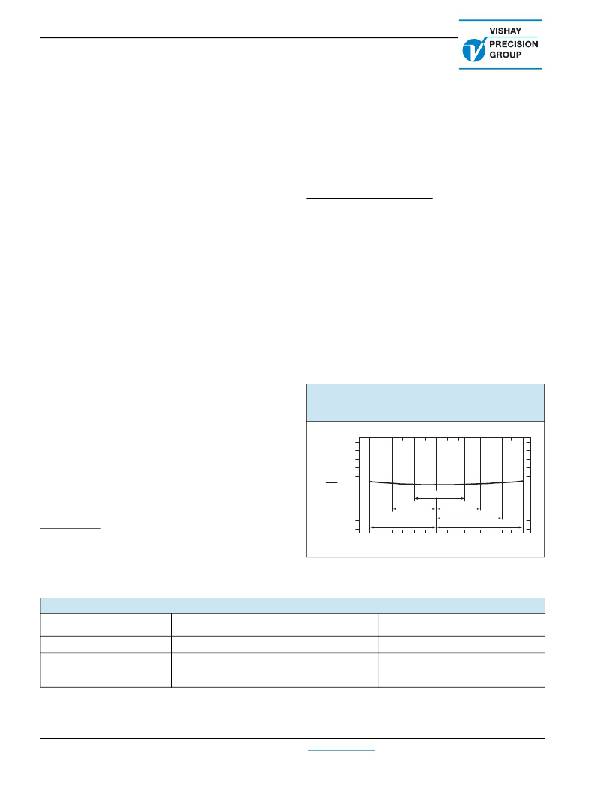- 您现在的位置:买卖IC网 > Sheet目录1013 > Y07061K00000T9L (Vishay Foil Resistors (Division of Vishay Precision Group))RES 1.0K OHM .4W .01% FOIL RAD
�� �
�
 �
�VAR�
�Vishay� Foil� Resistors�
�While� the� regular� foil� resistors� are� already� widely�
�acknowledged� as� the� leading� resistors� for� audio� applications,�
�the� special� “naked� Z-foil� resistor”� design� without� mold� or�
�encapsulation,� adds� an� additional� dimension� for� reducing�
�signal� distortion� and� increasing� clarity� in� signal� processing.�
�Our� application� engineering� department� is� available� to�
�advise� and� to� make� recommendations.� For� non-standard�
�technical� requirements� and� special� applications,� please�
�contact� us.�
�Bulk� Metal� Foil� resistors� owe� their� low� current� noise� and� high�
�linearity� to� the� type� of� material� they’re� made� of:� a� several�
�microns� thick� cold-rolled� metal� foil.� Every� real-world� resistor�
�possesses� certain� nonlinearity� of� its� electrical� resistance�
�(nonlinearity� of� volt-ampere� characteristic).� The� degree� of�
�nonlinearity� depends� on� two� factors:�
�?� Micro� factors:� internal� microstructure� of� resistive� material.�
�?� Macro� factors� (laser� trimming� cuts� cleanness,� micro�
�cracking� in� resistive� element� resulting� from� laser� trimming,�
�quality� of� contacts� between� resistive� element� and�
�terminals,� etc.).�
�As� for� the� microstructure,� the� most� linear� materials� are� pure�
�metals� and� metal� alloys� in� bulk,� such� as� the� foil� in� Bulk�
�Metal� ?� Foil� resistors.� When� the� same� materials� are�
�deposited� in� the� form� of� very� Thin� (nanometer� range)� Films,�
�they� are� less� linear.� Even� less� linear� are� composite� materials�
�like� resistive� cermets� in� Thick-Film� resistors� or� carbon�
�compositions� in� carbon� composition� resistors.�
�Shot or fluctuation noise� is� caused� by� the� discrete� nature�
�of� charge� carriers� and� fluctuation� of� their� number� in� the� unit�
�of� volume.� Shot� noise� can� be� reduced� by� reducing� bandwidth�
�or� increasing� current.� The� spectral� density� of� voltage� in� both�
�thermal� and� shot� noises� is� uniformly� distributed� in� entire�
�range� of� frequencies� (“white”� noise).� The� level� of� these� types�
�of� noise� does� not� depend� on� resistor� type� (resistive� element�
�material).�
�Current (excess, flicker) noise� has� 1/f� type� spectral� density�
�of� voltage� (“pink”� noise).� Its� level� essentially� depends� on�
�resistor� material.� Current� noise� can� be� reduced� by� a)�
�avoiding� use� of� the� low� frequency� band,� b)� reducing� current,�
�c)� increasing� the� volume� of� resistive� material,� i.e.� by� using�
�resistors� with� higher� rated� power� than� is� needed� for� proper�
�power� dissipation,� or� d)� using� less� noisy� resistive� materials.�
�Carbon� composition� resistors� are� the� noisiest� such� device�
�type� followed� by� Thick� Film� and� Thin� Film� resistors.� The� least�
�noisy� are� bulk� metals� and� metal� alloys� (foil,� wire).� At� that,�
�negligible� capacitance/inductance� of� foil� resistors� (when�
�compared� to� wirewound� resistors)� significantly� reduces�
�probability� of� self-excitation� or� "ringing"� of� amplification�
�circuit.This� is� why� Bulk� Metal� ?� foil� resistors� are� such� a� good�
�choice� for� low-noise� applications.�
�FIGURE� 1� -� TYPICAL� RESISTANCE� /�
�TEMPERATURE� CURVE�
�(Z-FOIL)�
�Δ� R�
�-� 100�
�The� macro� factors� that� cause� nonlinearity� in� other� types� of�
�resistors� aren’t� relevant� to� foil� resistors.� Indeed,� laser�
�trimming� of� foil� resistors� consists� of� cutting� shorting� jumpers�
�and� does� not� damage� current� carrying� portions� of� resistive�
�element.� Terminals� in� foil� resistors� are� an� integral� part� of� the�
�foil� resistive� element.� This� insures� high-quality� contact�
�between� resistive� element� and� terminals�
�+� 500�
�+� 400�
�+� 300�
�+� 200�
�+� 100�
�R� 0�
�(ppm)�
�TCR� chord� slopes� for� different� temperature� ranges�
�0.05� ppm/°C�
�Several� types� of� noise� are� found� in� resistors:�
�-� 200�
�-� 300�
�-� 0.1� ppm/°C�
�0.1� ppm/°C�
�0.14� ppm/°C�
�Thermal noise� is� caused� by� thermal� movement� of� electrons�
�in� resistive� material� and� gets� worse� as� resistance� and�
�temperature� increase.� Thermal� noise� can� be� reduced� by�
�-� 400�
�-� 500�
�-� 55�
�-� 0.16� ppm/°C� 0.2� ppm/°C�
�-� 25� 0� +� 25� +� 60� +� 75� +� 100�
�Ambient� Temperature� (°C)�
�+� 125�
�reducing� resistance,� temperature,� or� signal� bandwidth.�
�TABLE� 1� -� RESISTANCE� VERSUS� TCR� (-� 55� °C� to� +� 125� °C,� +� 25� °C� Ref.)� (2)�
�RESISTANCE� VALUE�
�(� ?� )�
�100� to� <� 100K�
�50� to� <� 100�
�10� to� <� 50�
�TYPICAL� TCR� AND� MAXIMUM� SPREAD� (ppm/°C)�
�±� 0.2� ±� 1.8�
�±� 0.2� ±� 2.8�
�±� 0.2� ±� 3.8�
�TIGHTEST� TOLERANCE�
�(%)�
�0.01�
�0.01�
�0.02�
�Note:�
�(1)� Pb� containing� terminations� are� not� RoHS� compliant,� exemptions� may� apply�
�(2)� For� non-standard� requests,� please� contact� application� engineering� at� foil@vishaypg.com�
�www.vishayfoilresistors.com�
�2�
�For� any� questions,� contact:� foil@vishaypg.com�
�Document� Number:� 63140�
�Revision:� 03-Jan-12�
�发布紧急采购,3分钟左右您将得到回复。
相关PDF资料
Y08500R10000F9R
RES .10 OHM .5W 1% FOIL SMD
Y092610R0000T9L
RES 10 OHM 8W .01% Z-FOIL TO-220
Y112110K0000T9R
RES 10K OHM .25W .01% FOIL SMD
Y14730R00500B0R
RES .005 OHM 3W .1% FOIL 3637
Y14880R00200B9R
RES .002 OHM 3W .1% FOIL SMD
Y16072R00000T9W
RES 2.0 OHM .5W .01% FOIL SMD
Y162410K0000T9R
RES 10K OHM .2W .01% FOIL 0805
Y163120K0000T9R
RES 20K OHM .3W .01% 1506 SMD
相关代理商/技术参数
Y07061K50000A0L
制造商:Vishay Foil Resistors 功能描述:RES 1.5K OHM .4W .05% RADIAL
Y0706220R000B9L
制造商:Vishay Foil Resistors 功能描述:RES 220 OHM .4W .01% RADIAL
Y0706220R000F0L
制造商:Vishay Foil Resistors 功能描述:RES 220 OHM .4W 1% RADIAL
Y0706220R000F9L
制造商:Vishay Foil Resistors 功能描述:RES 220 OHM .4W 1% RADIAL
Y0706220R000T9L
制造商:Vishay Foil Resistors 功能描述:RES 220 OHM .4W .01% RADIAL
Y0706224R000F0L
制造商:Vishay Foil Resistors 功能描述:RES 224 OHM .4W 1% RADIAL
Y0706249R280T9L
制造商:Vishay Foil Resistors 功能描述:RES 249.28 OHM .4W .01% RADIAL
Y070625K0000F0L
制造商:Vishay Intertechnologies 功能描述:VAR 25K000 1.0%